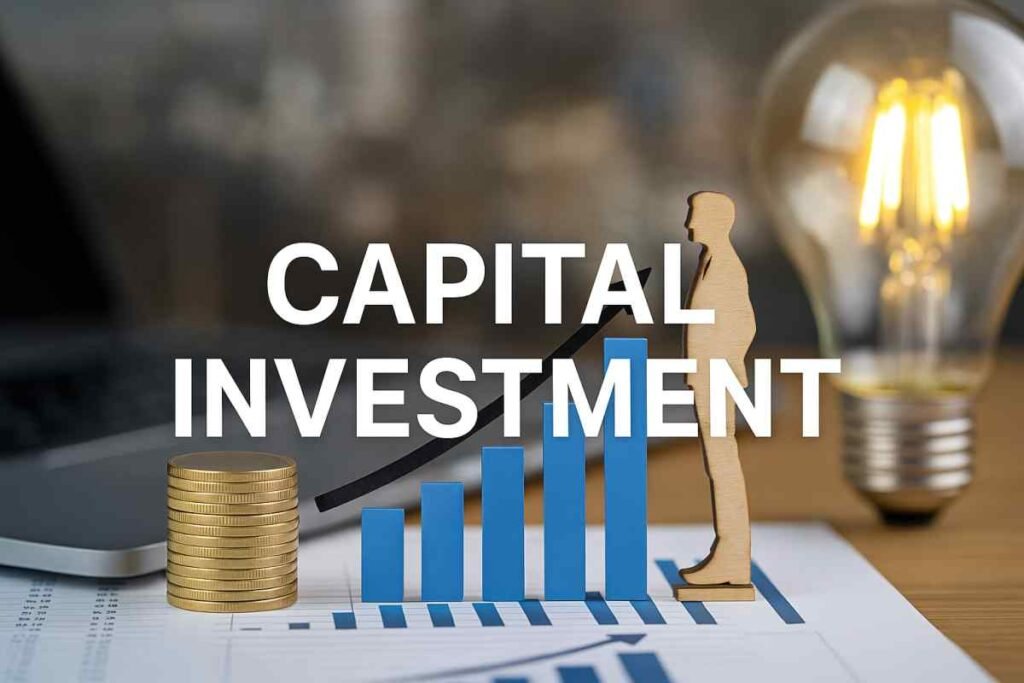Capital Investment: Definition, Examples and How It Works
Capital investment is a key concept in economics and finance — whether you’re running a business, managing personal wealth, or analyzing market trends. It drives economic growth, fuels innovation, and builds the foundation of productive systems.
What Is Capital Investment?
Capital investment refers to the money invested in a business or asset with the goal of generating long-term profit or value. This includes both:
- Tangible assets like machinery, buildings, vehicles, or land
- Intangible assets like software, patents, or brand development
It’s called “capital” because the investment is used to increase the productive capacity of a business or economy, not just for immediate consumption.
Key characteristics:
- Long-term in nature
- Often high-cost or high-value
- Aimed at growth, efficiency, or expansion
Capital Investment in Business
In business, it typically falls into 2 main categories:
- Fixed Capital Investment: physical or long-term assets like buying equipment, constructing factories, upgrading IT systems.
- Working Capital Investment: improving operational cash flow (less common in strict definitions).
Example: by modernizing its equipment at a cost of $1 million, the company positions itself for future expansion and higher earnings.
Math Example: If the investment of $1,000,000 increases output that brings in $300,000 in extra profit annually, the payback period is:
Payback Period = Investment / Annual Return = $1,000,000 / $300,000 = 3.33 years
Capital Investment for Individuals
Individuals also make capital investments, such as:
- Buying real estate
- Investing in a startup
- Purchasing tools to start a business
Example: an architect buys a high-performance laptop to enhance productivity and increase earning potential over time.
Math Example: if the laptop costs $2,000 and helps generate $500/month in additional revenue through faster project delivery, then:
ROI in 1 year = ($500 x 12 – $2,000) / $2,000 = 2000 / 2000 = 1 or 100%
Capital Investment in the Economy
At a national level, it boosts GDP, infrastructure, and innovation:
- Government spending on highways or clean energy
- VC firms funding AI startups
- Companies investing in robotics
Math Example: A government invests $5 billion in renewable energy projects that increase GDP by $1.2 billion annually. The economic return over 10 years:
Total Return = $1.2B x 10 = $12B → Net Gain = $12B – $5B = $7B
Capital Investment vs Operating Expense
| Capital Investment | Operating Expense |
|---|---|
| Long-term purchase or asset | Day-to-day running cost |
| Recorded as an asset | Recorded as expense |
| E.g., Buy a new machine | E.g., Pay for machine repair |
Why Capital Investment Matters
It drives:
- Growth: it enables companies and economies to scale.
- Innovation: it funds research, technology, and development.
- Tax and accounting implications: recorded as assets, not expenses, and are depreciated or amortized over time, allowing partial deductions each year that reduce taxable income, optimize cash flow, and impact net income, asset value, and financial ratios (improves long-term tax efficiency and has a major impact on how your financial health appears on paper).
- Job creation: new factories, services, and startups create employment
- Competitiveness: businesses gain advantages through better tools, systems, and capabilities.
- Wealth building: individuals invest in assets that grow over time.
Profitability Ratio Analysis and Fundamental Analysis Criterion | Formulas and Examples
Real-World Examples of Capital Investment
Let’s make this concept practical. Here are real-world examples across industries:
Small Business
A bakery spends €25,000 on a commercial oven that doubles its bread output, an equipment upgrade that boosts long-term revenue.
Tech Startup
A startup allocates $120,000 to hire developers and build its app. Though intangible, it strengthens the company’s intellectual property and digital infrastructure.
Real Estate
Purchasing a rental apartment for $200,000 to earn $1,500/month provides steady income and potential appreciation over time.
Agriculture
A farmer installs a $15,000 irrigation system to enhance crop yield, improving efficiency and long-term productivity.
Logistics Company
A delivery firm switches to electric vehicles to cut fuel costs and support sustainability—an investment with both financial and strategic value.
Final Thoughts: Is It Worth It?
Spending on long-term assets is more than just a cost—it’s planting seeds for future growth. Whether you’re a founder funding new technology or a country building infrastructure, smart long-term decisions shape the future.
Whether you’re:
- A business owner upgrading your tools,
- A government investing in energy,
- Or an individual buying property,
You’re making a strategic move aimed at lasting benefit.
Thoughtful investments like these lead to growth, stability, and long-term success.
Sources: AB Consulting Paris, PinterPandai, Investopedia
Venture Capital Investment: Examples, Cases, and Problem Solving

